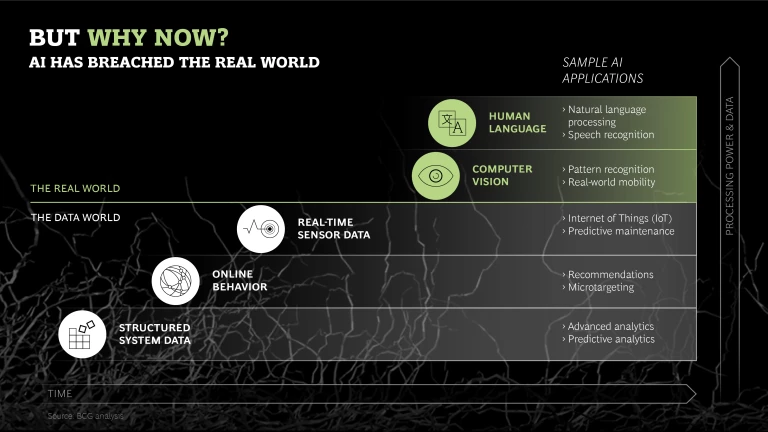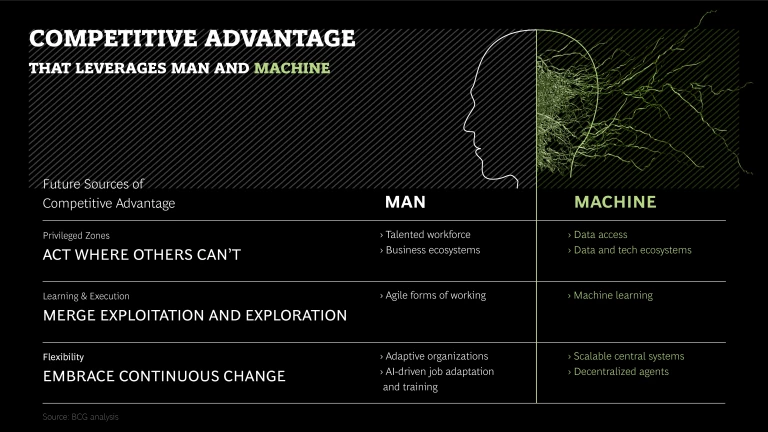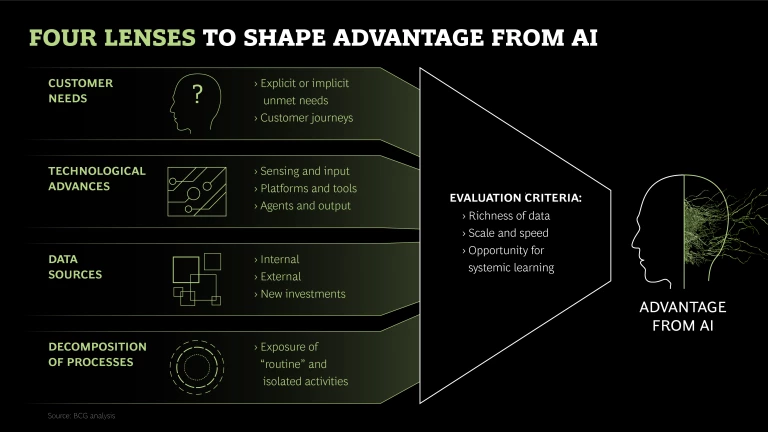U ntil recently, artificial intelligence (AI) was similar to nuclear fusion in unfulfilled promise. It had been around a long time but had not reached the spectacular heights foreseen in its infancy. Now, however, AI is realizing its potential in achieving human-like capabilities, so it is time to ask: How can business leaders harness AI to take advantage of the specific strengths of man and machine?
AI is swiftly becoming the foundational technology in areas as diverse as self-driving cars and financial trading. Self-learning algorithms are now routinely embedded in mobile and online services. Researchers have leveraged massive gains in processing power and the data streaming from digital devices and connected sensors to improve AI performance. And machines have essentially cracked speech and vision specifically and human communication generally. The implications are profound:
- Because they know how to speak, read text, and absorb and retain encyclopedic knowledge, machines can interact with people intuitively and naturally on a wide range of topics at considerable depth.
- Because they can identify objects and recognize optical patterns, machines can leave the virtual and join the real world.
A field that once disappointed its proponents is now striking remarkably close to home as it expands into activities commonly performed by humans. (See the exhibit and the sidebar.) AI programs, for example, have diagnosed specific cancers more accurately than radiologists. No wonder that traditional companies in finance, retail, health care, and other industries have started to pour billions of dollars into the field.
How Machines Think and Act
How Machines Think and Act
Deep Blue’s Defeat of World Chess Champion Garry Kasparov in 1997. Chess was originally considered an exercise that captures the essential tactical and strategic elements of human intelligence, and so it became the standard by which new AI algorithms were tested. For decades, programmers made little progress in defeating human players. But in 1997, Deep Blue, a computer developed by IBM, won the match against the world champion. Still, many people were disappointed when they realized that solving chess was not the same as solving artificial general intelligence. They did not like that Deep Blue relied heavily on brute force and memory. The program did not learn and certainly did not excel at any task but chess.
The event, however, revealed two important lessons. First, machines solve problems differently than people do. Second, many “intelligent” tasks are ultimately narrow and so can be solved by specialized programs.
With AlphaGo’s 2016 victory over Lee Sedol in Go, computer dominance of board games was complete. AlphaGo, developed by DeepMind Technologies, relied on deep learning—a neural network, or computational brain, with multiple layers—to beat a Go world champion. An intriguing fact about this match was how the machine prepared: having run out of human games to study, it spent the final months before the match playing against itself.
Watson’s Victory over Top Jeopardy Champs in 2011. By winning this challenging game show, IBM’s Watson effectively passed a Turing test of human-like intelligence. The performance showcased state-of-the-art speech recognition, natural-language processing, and search. The victory, however, was clinched by a different skill: Watson outperformed the other contestants in the “Daily Doubles,” in which players can wager all or part of their current winnings to secure a decisive lead. Making the best bet requires fast sequential reasoning, knowledge of game theory, and an ability to calculate probabilities and outcomes correctly. All these are areas in which humans are notoriously weak, as the Nobel laureate Daniel Kahneman observed in his famous book Thinking, Fast and Slow. Machines, on the other hand, think fast and fast in making data-heavy decisions.
Google’s Demonstration of a Self-Driving Car in 2012. Google is not the pioneer of self-driving cars. That distinction arguably goes to Ernst Dickmanns, a German computer vision expert who rode 1,785 kilometers in autonomous mode on a German autobahn in 1995, reaching speeds above 175 kilometers an hour.
Dickmanns, however, never had to turn left. In their 2004 book The New Division of Labor, Frank Levy and Richard Murnane argue that “executing a left turn against oncoming traffic involves so many factors that it is hard to imagine discovering the set of rules that can replicate a driver’s behavior.” Google’s self-driving car, however, routinely managed this exercise without incident. The car combined robots, computer vision, and real-time data processing to produce the ultimate intelligent agent that was capable of both exploring and learning from the real world.
Because AI systems think and interact, they are invariably compared to people. But while humans are fast at parallel processing (pattern recognition) and slow at sequential processing (logical reasoning), computers have mastered the former in narrow fields and are superfast in the latter. Just as submarines don’t swim, machines solve problems and accomplish tasks in their own way.
Without further quantum leaps in processing power, machines will not reach artificial general intelligence (AGI): the combination of vastly different types of problem-solving capabilities—the hallmark of human intelligence. Today’s robo-car, for example, doesn’t exhibit what we would consider common sense, such as abandoning an excursion to assist a child who has fallen off her bicycle. But when properly applied, AI excels at performing many business tasks quickly, intelligently, and thoroughly.
Artificial intelligence is no longer an elective. It is critical for companies to figure out how humans and computers can play off each other’s strengths as intertwined actors to create competitive advantage.
It is critical for companies to figure out how humans and computers can play off each other’s strengths as intertwined actors to create competitive advantage.
The Evolution of Competitive Advantage
In simpler times, a technology tool, such as Walmart’s logistics tracking system in the 1980s, could serve as a source of advantage. AI is different. The naked algorithms themselves are unlikely to provide an edge. Many of them are in the public domain, and businesses can access open-source software platforms, such as Google’s TensorFlow. OpenAI, a nonprofit organization started by Elon Musk and others, is making AI tools and research widely available. And many prominent AI researchers have insisted on retaining the right to publish their results when joining companies such as Baidu, Facebook, and Google.
Rather than scrap traditional sources of competitive advantage, such as position and capability, AI reframes them. (See the exhibit.) Companies, then, need a fluid and dynamic view of their strengths. Positional advantage, for example, generally focuses on relatively static aspects that allow a company to win market share: proprietary assets, distribution networks, access to customers, and scale. These articles of faith have to be reimagined in the AI world.
Let’s look at three examples of how AI shifts traditional notions of competitive advantage.
- Data. AI’s strongest applications are data-hungry. Pioneers in the field, such as Facebook, Google, and Uber, have each secured a “privileged zone” by gaining access to current and future data, the raw material of AI, from their users and others in ways that go far beyond traditional data harvesting. Their scale gives them the ability to run more training data through their algorithms and thus improve performance. In the race to leverage fully functional self-driving cars, for example, Uber has the advantage of collecting 100 million miles of fleet data daily from its drivers. This data will eventually inform the company’s mobility services. Facebook and Google take advantage of their scale and depth to hone their ad targeting. Not all companies can realistically aspire to be Facebook, Google, or Uber. But they do not need to. By building, accessing, and leveraging shared, rented, or complementary data sets, even if that means collaborating with competitors, companies can complement their proprietary assets to create their own privileged zone. Sharing is not a dirty word. The key is to build an unassailable and advantaged collection of open and closed data sources.
- Customer Access. AI also changes the parameters of customer access. Well-placed physical stores and high-traffic online outlets give way to customer insights generated through AI. Major retailers, for example, can run loyalty, point-of-sale, weather, and location data through their AI engines to create personalized marketing and promotion offers. They can predict your route and appetite—before you are aware of them—and conveniently provide familiar, complementary, or entirely new purchasing options. The suggestive power of many of these offers has generated fresh revenue at negligible marginal cost.
- Capabilities. Capabilities traditionally have been segmented into discrete sources of advantage, such as knowledge, skills, and processes. AI-driven automation merges these areas in a continual cycle of execution, exploration, and learning. As an algorithm incorporates more data, the quality of its output improves. Similarly, on the human side, agile ways of working blur distinctions between traditional capabilities as cross-functional teams build quick prototypes and improve them on the basis of fast feedback from customers and end users. AI and agile are inherently iterative. In both, offerings and processes become continuous cycles. Algorithms learn from experience, allowing companies to merge the broad and fast exploration of new opportunities with the exploitation of known ones. This helps companies thrive under conditions of high uncertainty and rapid change.
In addition to reframing specific sources of competitive advantage, AI helps increase the rate and quality of decision making. For specific tasks, the number of inputs and the speed of processing for machines can be millions of times higher than they are for humans. Predictive analytics and objective data replace gut feel and experience as a central driver of many decisions. Stock trading, online advertising, and supply chain management and pricing in retail have all moved sharply in this direction.
To be clear, humans will not become obsolete, even if there will be dislocations similar to (but arguably more rapid than) those during the Industrial Revolution. First, you need people to build the systems. Uber, for instance, has hired hundreds of self-driving vehicle experts, about 50 of whom are from Carnegie Mellon University’s Robotics Institute. And AI experts are the most in-demand hires on Wall Street. Second, humans can provide the common sense, social skills, and intuition that machines currently lack. Even if routine tasks are delegated to computers, people will stay in the loop for a long time to ensure quality.
In this new AI-inspired world, where the sources of advantage have been transformed, strategic issues morph into organizational, technological, and knowledge issues, and vice versa. Structural flexibility and agility—for both man and machine—become imperative to address the rate and degree of change.
Scalable hardware and adaptive software provide the foundation for AI systems to take advantage of scale and flexibility. One common approach is to build a central intelligence engine and decentralized semiautonomous agents. Tesla’s self-driving cars, for example, feed data into a central unit that periodically updates the decentralized software.
Winning strategies put a premium on agility, flexible employment, and continual training and education. AI-focused companies rarely have an army of traditional employees on their payroll. Open innovation and contracting agreements proliferate. As the chief operating officer of an innovative mobile bank admitted, his biggest struggle was to transform members of his leadership team into skilled managers of both people and robots.
Getting Started
Companies looking to achieve a competitive edge through AI need to work through the implications of machines that can learn, conduct human interactions, and engage in other high-level functions—at unmatched scale and speed. They need to identify what machines do better than humans and vice versa, develop complementary roles and responsibilities for each, and redesign processes accordingly. AI often requires, for example, a new structure, of both centralized and decentralized activities, that can be challenging to implement. Finally, companies need to embrace the adaptive and agile ways of working and setting strategy that are common at startups and AI pioneers. All companies might benefit from this approach, but it is mandatory for AI-enabled processes, which undergo constant learning and adaptation for both man and machine.
Companies need to embrace the adaptive and agile ways of working and setting strategy that are common at startups and AI pioneers.
Executives need to identify where AI can create the most significant and durable advantage. At the highest level, AI is well suited to areas with huge amounts of data, such as retail, and to routine tasks, such as pricing. But that heuristic oversimplifies the playing field. Increasingly, all corporate activities are awash in data and capable of being broken down into simple tasks. (See the exhibit.) We advocate looking at AI through four lenses:
- Customer needs
- Technological advances
- Data sources
- Decomposition of processes
First, define the needs of your customers. AI may be a sexy field, but it always makes sense to return to the basics in building a business. Where do your current or potential customers have explicit or implicit unmet needs? Even the most disruptive recent business ideas, such as Uber and Airbnb, address people’s fundamental requirements.
Second, incorporate technological advances. The most significant developments in AI generally involve assembling and processing new sources of data and making partially autonomous decisions. Numerous services and platforms can capture incoming data from databases, optical signals, text, and speech. You will probably not have to build such systems yourself. The same is true on the back end as a result of the increasing availability of output technologies such as digital agents and robots. Consider how you can use such technologies to transform your processes and offerings.
Third, create a holistic architecture that combines existing data with new or novel sources, even if they come from outside. The stack of AI services has become reasonably standardized and is increasingly accessible through intuitive tools. Even nonexperts can use large data sets.
Finally, break down processes and offerings into relatively routinized and isolated elements that can be automated, taking advantage of technological advances and data sources. Then, reassemble them to better meet your customers’ needs.
For many organizations, these steps can be challenging. To apply the four lenses systematically, companies need to be familiar with the current and emerging capabilities of the technology and the required infrastructure. A center for excellence can serve as a place to incubate technical and business acumen and disseminate AI expertise throughout the organization. But ultimately, AI belongs in and belongs to the businesses and functions that must put it to use.
Only when humans and machines solve problems together—and learn from each other—can the full potential of AI be achieved.
The BCG Henderson Institute is Boston Consulting Group’s strategy think tank, dedicated to exploring and developing valuable new insights from business, technology, and science by embracing the powerful technology of ideas. The Institute engages leaders in provocative discussion and experimentation to expand the boundaries of business theory and practice and to translate innovative ideas from within and beyond business. For more ideas and inspiration from the Institute, please visit
Featured Insights
.












